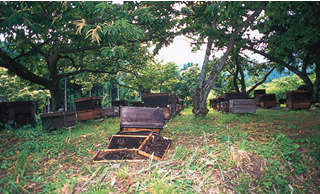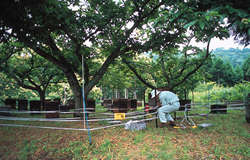|
At this time, I have a sad report to make. A bear appeared in our bee farm in Kagamino Town and attacked the beehives.
On the morning of July 10, I rushed to the bee farm of our company in Koshihata located in the northernmost part of the town on receipt of a report from the town office of Kagamino. When I arrived at the bee farm, I immediately felt there was something unusual in the air. Several beehives had been overturned and some of them had been eaten away. Honeybees whose beehives had been damaged were flying about. The scattered honeycomb plates must have contained larvae of bees and honey, but they were eaten together with the honeycomb plates.
In the world of the fairy tale "Winnie the Pooh," there is a familiar heart-warming scene in which this character licks honey from a honey pot in a very enjoyable manner. But in the actual world of beekeeping, this is a very serious occurrence. Not only is the honey eaten up, the honeybees that attack the bear are lost. This is because once a honeybee stings, its stinger is torn off from its body and it dies. Moreover, the beehives that were attacked this time were those of the cultivation swarms that we had fostered from the spring of this year and, with their number gradually increasing, we had been anticipating that these honeybees would have been very productive. Thus, it was quite a disappointment for us.

Bee farm at our company grounds in Koshihata right after a bear attack
|
|
Two years ago, a bee farm in the neighboring Okutsu Town was attacked by a bear, just like the attack that took place this time, and we gave up on expecting a good harvest at that site. This bee farm in Koshihata, which is a very good one, was an alternative site that we found at that time. At the foot of Mt. Izumi, which is the highest mountain in Kagamino Town and at an altitude of about 600 m, the bee farm under the chestnut trees is the most suitable place for honeybees to pass the summer. This is because where the bee farm is located is cooler by three to four degrees in summer than in the plains and there are a lot of broadleaf trees in the mountains around. Though it is located at the northernmost part of Kagamino Town, several farming families live nearby and there is a tourist apple farm next to the bee farm. Thus, the bee farm is not a place where a bear would normally appear. However, once a bear get a taste of the honey from an attacked hive, it can appear again at any given moment. Thus, we must tighten our guard against intrusions by bears. On the day following of the attack, we set up an electric fence to protect the area against bears. A current of several thousands of volts flows through the electric wire around the bee farm and the ground. If the bear touches the electric wire, it receives an electrostatic shock after which it tends to run away from the area in confusion. Once a bear receives a shock, it is said to never approach that particular area again.
Originally, bears lived deep in the mountains, eating tree sprouts and nuts as well as fish. Recently, however, they have been approaching areas close to villages because they can no longer find sufficient food in the wild. This is due to deforestation and the planting of conifer trees. Though bear attacks are a severe blow to us as beekeepers, we cannot put all of the blame on the bears alone. Furthermore, it is very unlikely that bears are fond of the idea of being in or roaming about the vicinity of villages where cars are always coming and going.

Electric fence to guard against bears
|
|
I have heard that some bears come and go across prefectural boundaries such as those of Tottori and Hyogo Prefectures. However, there are only four wild bears whose existence has been confirmed and registered in Okayama Prefecture. A neighbor of the bee farm, that was attacked this time, saw a bear. According to the witness account, the bear, which was not very large, was in the company of three small bear cubs. If this is true, there must be at least seven wild bears in Okayama Prefecture. Damage by bears is surely a sad event, but I can't help but feel even sadder when I realize that our natural environment was once plentiful enough to nourish a greater number of bears. It is really unfortunate that our natural environment, one that could once nourish so many animals, is dwindling.
|





